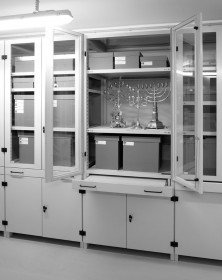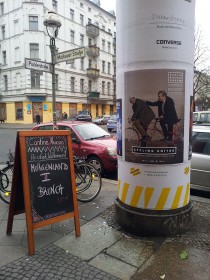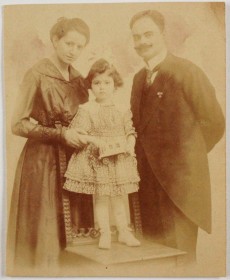
View of Jewish Musem-Berlin storage,© Jewish Museum Berlin, photo: Jens Ziehe
It’s cold. The neon light casts a harsh glare. A gray cabinet stands next to another along white walls. The room feels sterile. The air conditioning hums. A gloomy place.
I put on blue, latex gloves, open one of the cabinets and take out a gray carton. Contours of an item shimmer from under layers of tissue paper. Carefully, I take the object out of the carton and free it from the paper; a microcosm of history presents itself, as if this gloomy place accentuates the aura of the item, the room itself taking a whole step back. → continue reading
Pessach is approaching – the festival of exodus and freedom. This year, there is less talk of having the festive meal at large community gatherings. It is obvious, although unspoken, that smaller gatherings in the home make more sense. We are becoming alienated from our community centers through fear. Keep a low profile. Don’t speak Hebrew on the streets. Some people are removing the mezuzah from their front doorposts, a traditional object that visibly identifies a Jewish household. There is a mood of caution and nervous apprehension.
How did it get to this point?

Advertisement with Imam Ferid Heider and Rabbi Daniel Alter for the “Cycling Unites”-Critical-Mass-Tour in Berlin on 22 March 2015, photo: Michal Friedlander
June, 2014
A drunken man rolls slowly off the train platform and plops onto the tracks at Friedrichstrasse station. Around sixty people witness the moment and look away, hoping that someone else will solve the stinky, awkward problem. And so it was. An Italian and an Israeli jumped down to haul the semi-conscious man to safety. The passengers walked around the startled little group, pressing forward to make the oncoming train.
July 2014
Dinner party small talk. The discussions nearest me are taking a more political turn and I am just not in the mood to talk about Israel. Too late. The young man next to me asks if I saw the recent pro-Palestinian demonstration on the Kurfürstendamm? He becomes very still and lowers his voice. → continue reading
Shortly after the opening of our temporary exhibition “Snip it!”, the Jewish Museum received as a bequest the estate of Fritz Wachsner (1886 – 1942). Included in this delivery was a bundle of letters so enormous that I didn’t have time, in creating an inventory, to delve into each individual piece. But one letter caught my attention. “[…] Your assessment of the circumcision issue […]”, wrote Wachsner on 24. July 1919 to his – then very pregnant – wife Paula’s uncle Anselm Schmidt (1875 – 1925). I read on and suddenly found myself in the middle of a nearly one-hundred-year-old internal Jewish debate on circumcision.

Fritz Wachsner with his wife Paula and their first-born child, Charlotte, studio portrait, ca. 1916 © Jewish Museum Berlin, photo: Jörg Waßmer, Gift of Marianne Meyerhoff
At the time, Fritz Wachsner was 33-year-old teacher in the town of Buckow in Brandenburg. In the five-page letter he clarifies the reasons for his hostile stance towards the Bris. He was an assimilated German Jew and belonged to a Reform Jewish congregation. As he explains to his uncle, he was “raised fairly orthodox” but, in the course of his university studies in Berlin and Jena as well as at the Academy for the Study of Judaism in Berlin, he learned “to know and appreciate the spirit of Judaism freed from every non-German embellishment”. He became persuaded that the religion should evolve continually and be “modernized and improved”. Wachsner’s maxim was: “Become German, outside as well as inside the religious community”, the overtones of which are especially → continue reading


